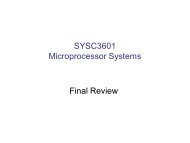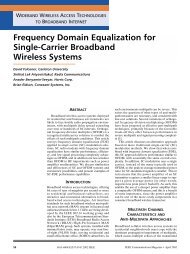Image Reconstruction for 3D Lung Imaging - Department of Systems ...
Image Reconstruction for 3D Lung Imaging - Department of Systems ...
Image Reconstruction for 3D Lung Imaging - Department of Systems ...
Create successful ePaper yourself
Turn your PDF publications into a flip-book with our unique Google optimized e-Paper software.
Cheney et al introduced a diagonal matrix, R = diag(H T H), as the prior used in<br />
their NOSER algorithm [35]. This matrix is diagonal, and with SVD decomposition, the<br />
regularized solution can be expressed as<br />
with<br />
ˆx =<br />
f =<br />
M�<br />
i=1<br />
f uTi d<br />
vi<br />
σi<br />
σ 2 i<br />
σ 2 i + λr2 i<br />
f are the “filter factors”, ri are the diagonal elements <strong>of</strong> R, and σi are the singular values<br />
<strong>of</strong> R. For small singular values f → 1 and <strong>for</strong> large singular values f → 0.<br />
3.4.1 Thoughts on Regularization<br />
The use <strong>of</strong> Tikhonov style regularization techniques is equivalent to introducing a priori<br />
in<strong>for</strong>mation to the reconstruction process. The fundamental prior in<strong>for</strong>mation <strong>of</strong> the conductivity<br />
solution is that it is a positive function, Such methods provide stability but <strong>for</strong>ce<br />
solutions to be smooth in some sense thus eliminating the possibility <strong>of</strong> non-smooth solutions.<br />
This is reasonable given that the undesired, noise dominated, solutions contain<br />
components with high spatial frequencies.<br />
One way in which the generalized Tikhonov regularization method can be understood<br />
to work, is that it draws the solution towards the null space N(R) <strong>of</strong> the regularization<br />
matrix R [114]. If we use, <strong>for</strong> example, the first difference matrix, the solution is drawn<br />
toward a constant distribution because a constant solution <strong>for</strong>ms the basis <strong>for</strong> the null<br />
space <strong>of</strong> the first difference matrix. Moreover if we have some in<strong>for</strong>mation on the true<br />
resistivity distribution, the regularization matrix can be constructed in such a way that<br />
the solution is drawn towards the known distribution by the regularization. This can be<br />
implemented by penalizing the difference between the reconstructed conductivity, σ, and<br />
the a priori assumption about the conductivity instead <strong>of</strong> the just penalizing the solution.<br />
Symbolically, rather than minimize equation 3.7 we minimize<br />
ˆx = arg min<br />
x<br />
�<br />
�Hx − z� 2 + λ 2 �R(x − x ∗ )� 2�<br />
(3.23)<br />
where x ∗ is the a priori assumed distribution. This idea was evaluated by Vauhkonen<br />
et al in [113] and [114]. In [113] the conductivity distribution was approximated as a<br />
linear combination <strong>of</strong> some pre-selected basis functions that were constructed from prior<br />
in<strong>for</strong>mation on the structures and conductivities. The method, called the Basis Constraint<br />
Method (BCM), produced good results when the priors were correct but provided misleading<br />
results when the prior was incorrect. Here misleading means that the solutions contained<br />
structural artefacts due to the prior that were not part <strong>of</strong> the true conductivity. In [114]<br />
Vauhkonen et al used the same kind <strong>of</strong> idea but rather than <strong>for</strong>cing the solution to be<br />
in the subspace spanned by pre-selected basis functions they only “draw” the solution<br />
towards the subspace. This method, called the Subspace Regularization Method, provided<br />
an improvement over the BCM in that they could partially avoid misleading results even if<br />
the prior in<strong>for</strong>mation was not correct.<br />
43





